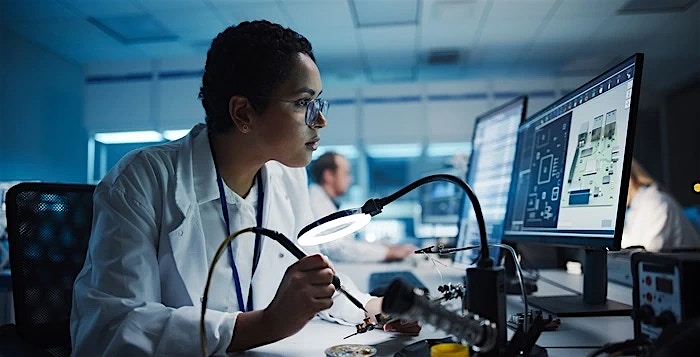In 2025, the semiconductor industry finds itself at a critical inflection point — one defined by immense technological progress, a recalibration of global supply chains and a rising urgency for intelligent, scalable and secure systems. The role of semiconductors is expanding far beyond traditional computation — now acting as the foundation for Generative AI (GenAI), intelligent edge systems, next-gen mobility and future-ready digital infrastructure.
At HCLTech, we see this evolution as both a challenge and an unprecedented opportunity to co-create the future with our clients and partners. This article explores the defining trends shaping the semiconductor landscape in 2025.
Generative AI and chip customization redefine demand
GenAI continues to disrupt the digital economy, which has triggered a surge in demand for high-performance computing and purpose-built silicon. Industries are rapidly moving away from one-size-fits-all chip architectures toward highly specialized Application-Specific Integrated Circuits (ASICs), domain-specific GPUs and custom accelerators designed for intensive AI workloads.
Automotive OEMs, such as Tesla and new-age players like Nio and Xpeng, are taking semiconductor design in-house to create chips that meet the latency, power and performance requirements of autonomous vehicles. Similarly, telecom giants, including Cisco, Huawei and Ericsson, are innovating with proprietary chipsets to meet the demands of cloud-native, software-defined networks. This convergence of GenAI and chip customization is cementing semiconductors as the nervous system of innovation across industries, from healthcare to manufacturing to consumer electronics.
Smart manufacturing ushers in the next era of productivity
To meet the swelling demand for advanced chips, manufacturers are embracing Industry 4.0 principles at scale. AI-powered predictive maintenance, digital twins for fabrications and IoT-enabled equipment monitoring, are transforming wafer fabrication into a highly data-driven discipline. Governments around the world are prioritizing semiconductor sovereignty, driving reshoring efforts, incentivizing local fabrications and investing heavily in national semiconductor missions. These initiatives are not only reshaping the global supply chain landscape but also accelerating the shift toward zero-defect manufacturing and sustainability in chip production.
HCLTech is enabling this transformation through its suite of digital engineering, smart factory and AI-ops capabilities that help semiconductor clients boost throughput, reduce costs and build resilience across their operations.
Silicon innovation moves beyond Moore’s Law
The era of miniaturization is evolving into an era of material science and heterogeneous integration. As node sizes approach 2nm and below, thermal management and energy efficiency are taking center stage.
Innovations in 3D-packaging and chiplets are creating new pathways to performance, allowing for modular scaling without the economic or physical constraints of traditional scaling. Materials such as Silicon Carbide (SiC) and Gallium Nitride (GaN) are disrupting power electronics by delivering high efficiency under extreme thermal and electrical conditions, especially in EVs and high-voltage industrial applications.
Additionally, quantum materials and neuromorphic architectures are beginning to mature, offering glimpses into the next frontier of computing. These advances are expanding the boundaries of what’s possible across automotive, aerospace, cloud data centers and industrial robotics.
Data-driven design and decision-making take the lead
The semiconductor value chain — from front-end design to back-end test and assembly — is being reshaped by the power of data. AI/ML platforms are enhancing yield prediction, defect detection and process optimization, turning data into a strategic asset. Firms are now leveraging real-time analytics to create digital threads across product lifecycles, enabling traceability, faster design iterations and intelligent automation in quality assurance. This shift is particularly critical as companies aim to shorten time-to-market while improving design complexity and reliability.
At HCLTech, our TestSphere™ and silicon lifecycle solutions are helping clients integrate these insights into every stage of the chip development journey.
GenAI in semiconductor design: A double-edged sword
While GenAI is transforming everything from software development to drug discovery, its influence on semiconductor design is particularly profound. Chipmakers are deploying GenAI models to automate RTL design, optimize power-performance-area trade-offs and accelerate verification cycles. However, adoption is not without friction. The complexity of IP protection, the need for domain-specific datasets and the rigor of functional safety and validation standards, present significant hurdles. Leading players are investing heavily to overcome these barriers, confident that GenAI will become a mainstay in future EDA toolchains.
Service providers become strategic co-innovators
The semiconductor ecosystem is no longer defined by siloed players — it is now a collaborative network of foundries, IP vendors, EDA tool providers, hyperscalers and increasingly, end-to-end service partners.
Service providers are moving up the value chain, playing a pivotal role in:
- Next-generation R&D and prototyping
- Edge AI and embedded systems design
- Cybersecurity in silicon
- Workforce transformation and talent upskilling
- Digital thread enablement across design to delivery
By delivering holistic, domain-aware solutions, HCLTech as a strategic partner is enabling clients to adapt faster, scale smarter and innovate deeper.
Charting the road ahead
The semiconductor industry in 2025 is not just advancing, it’s redefining itself. It is simultaneously responding to rising global demand, geopolitical realignment and an insatiable need for innovation across every aspect of modern life. While challenges such as supply chain vulnerabilities, skilled talent shortages and ecosystem complexity persist, the future remains bright for those who embrace transformation.
At HCLTech, we are proud to stand at the forefront of this evolution, helping clients pioneer the next wave of technology by co-innovating across silicon, systems and software. As the world becomes more connected, intelligent and autonomous, semiconductors will remain the pulse of progress and the blueprint for what’s possible.
Special thanks to Nikita Sarda for her valuable contributions, bringing depth and clarity to our narrative through her strategic insights.





